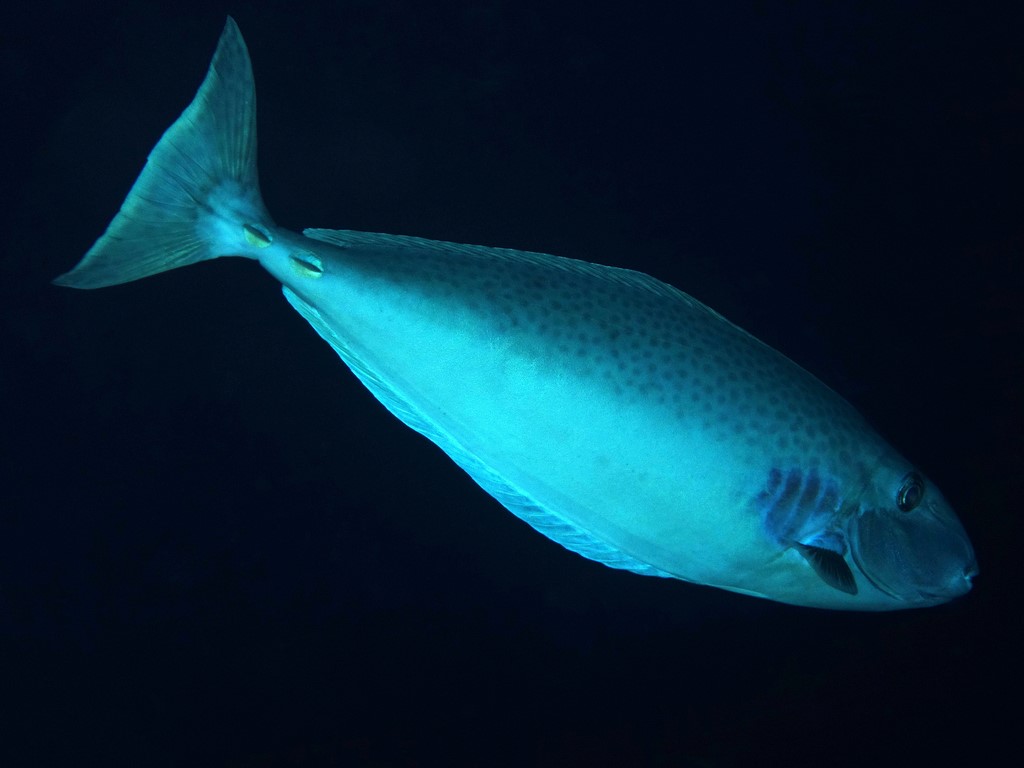NASO LOPEZI - (HERRE, 1927)
Picture courtesy of: Alain Daoulas
Actinopterygii (Gigaclass) > Actinopteri (Class) > Teleostei (Subclass) > Acanthuriformes (Order) > Acanthuridae (Family) > Naso (Genus)
Slender Unicornfish, Elongate Unicornfish, Lopez' Unicornfish, Slender Unicorn, Naga-tenguhagi-modoki, ナガテングハギモドキ, 剥皮仔, 背斑雙板盾尾魚,
Synonyme
Naso lopezii (Herre, 1927)
-------------------------
Actinopterygii (Gigaclass) > Actinopteri (Class) > Teleostei (Subclass) > Acanthuriformes (Order) > Acanthuridae (Family) > Naso (Genus)
Slender Unicornfish, Elongate Unicornfish, Lopez' Unicornfish, Slender Unicorn, Naga-tenguhagi-modoki, ナガテングハギモドキ, 剥皮仔, 背斑雙板盾尾魚,
Synonyme
Naso lopezii (Herre, 1927)
-------------------------
Description
Dorsal spines (total): 5; Dorsal soft rays (total): 27-30; Anal spines: 2; Anal soft rays: 26-30; Pectoral fin rays: 17. Body very elongate, its depth: 3.3-3.7 times in SL. No horn-like projection on snout; Two bony plates on caudal peduncle, the keel rounded to angular (not pointed); Dorsal and ventral profiles of head equally convex; Interorbital broad, nearly flat; First dorsal spine longest and strongest; Caudal fin slightly emarginate, higher than body depth. Max. length: 60.0 cm SL. Depth range: 6 - 70 m, usually: 20 - 50 m.
Color
Bluish grey body color, sometimes displays large whitish patch on side in area around pectoral fin; Has numerous black close-set spots on the upper half of its body and tail, and is white ventrally. Males assumes dark anterior body during courtship displays.
Etymology
Naso: from Latin, nasus = nose. Referring to “protuberance in the shape of a horn or a large magnifying glass on the nose” (translation, actually forehead) on adults of Naso fronticornis (= unicornis).
Dorsal spines (total): 5; Dorsal soft rays (total): 27-30; Anal spines: 2; Anal soft rays: 26-30; Pectoral fin rays: 17. Body very elongate, its depth: 3.3-3.7 times in SL. No horn-like projection on snout; Two bony plates on caudal peduncle, the keel rounded to angular (not pointed); Dorsal and ventral profiles of head equally convex; Interorbital broad, nearly flat; First dorsal spine longest and strongest; Caudal fin slightly emarginate, higher than body depth. Max. length: 60.0 cm SL. Depth range: 6 - 70 m, usually: 20 - 50 m.
Color
Bluish grey body color, sometimes displays large whitish patch on side in area around pectoral fin; Has numerous black close-set spots on the upper half of its body and tail, and is white ventrally. Males assumes dark anterior body during courtship displays.
Etymology
Naso: from Latin, nasus = nose. Referring to “protuberance in the shape of a horn or a large magnifying glass on the nose” (translation, actually forehead) on adults of Naso fronticornis (= unicornis).
lopezi: in honor of G. A. Lopez, collector for the Philippine Bureau of Science.
Original description: Naso lopezi Herre, 1927 - Type locality: Ambil Island, China Sea, southwest of Manila Bay, Philippines.
Distribution
Eastern Indian Ocean, western Pacific: South China Sea east to New Ireland (Papua New Guinea) and Vanuatu, north to central Japan, south to northern Australia and New Caledonia.
Original description: Naso lopezi Herre, 1927 - Type locality: Ambil Island, China Sea, southwest of Manila Bay, Philippines.
Distribution
Eastern Indian Ocean, western Pacific: South China Sea east to New Ireland (Papua New Guinea) and Vanuatu, north to central Japan, south to northern Australia and New Caledonia.
Biology
Inhabits coastal to outer reef slopes subject to strong currents. Solitary or in groups and sometimes in large schools. Generally uncommon species. Feeds on zooplanktons.
Last update: 5, May 2022
Inhabits coastal to outer reef slopes subject to strong currents. Solitary or in groups and sometimes in large schools. Generally uncommon species. Feeds on zooplanktons.
Last update: 5, May 2022
